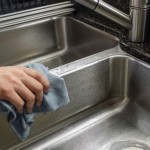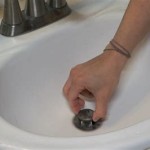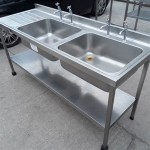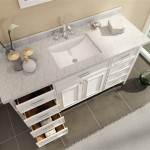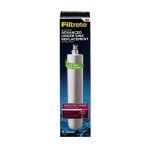American Standard Undermount Kitchen Sink: A Comprehensive Guide
The kitchen sink is an indispensable element of any functional kitchen. It serves as a central hub for food preparation, cleaning, and various other daily tasks. Among the plethora of options available in the market, the American Standard undermount kitchen sink stands out as a popular choice for its durability, aesthetic appeal, and efficient design. This article provides a comprehensive overview of the American Standard undermount kitchen sink, covering its various aspects, benefits, and considerations for selection and installation.
An undermount sink, as the name suggests, is installed beneath the countertop. This installation method creates a seamless transition between the countertop and the sink basin, eliminating the lip or rim that is characteristic of drop-in or top-mount sinks. This design not only contributes to a clean and modern aesthetic but also simplifies the process of cleaning the countertop, as debris can be easily wiped directly into the sink.
American Standard, a renowned manufacturer of plumbing fixtures, offers a diverse range of undermount kitchen sinks crafted from various materials, including stainless steel, fireclay, and cast iron. Each material possesses unique properties that influence the sink's durability, resistance to stains and scratches, and overall appearance. The selection of the appropriate material depends on individual preferences, budget considerations, and the anticipated usage of the sink.
Key Features and Benefits of American Standard Undermount Kitchen Sinks
American Standard undermount kitchen sinks offer several advantages that make them a desirable option for many homeowners. Understanding these key features and benefits is crucial for making an informed decision when choosing a kitchen sink.
Seamless Integration and Aesthetic Appeal: The primary advantage of an undermount sink is its seamless integration with the countertop. This creates a clean, uninterrupted surface that enhances the overall aesthetic of the kitchen. Without the lip or rim of a top-mount sink, the countertop material is more prominently displayed, contributing to a more upscale and sophisticated look. This design also allows for easier cleaning, as crumbs and spills can be effortlessly wiped directly into the sink without encountering any obstructions.
Enhanced Countertop Space: Because an undermount sink is installed beneath the countertop, it maximizes the usable space on the countertop. The absence of a protruding rim allows for a larger, more unobstructed work area, which is particularly beneficial in smaller kitchens where countertop space is limited. This extra space can be used for food preparation, appliance placement, or simply as a staging area for various kitchen tasks.
Durability and Material Options: American Standard offers undermount kitchen sinks in a variety of durable materials, including stainless steel, fireclay, and cast iron. Each material offers different levels of resistance to scratches, stains, and heat. Stainless steel is a popular choice for its affordability, durability, and resistance to corrosion. Fireclay sinks, known for their classic and elegant appearance, are highly resistant to chipping and staining. Cast iron sinks, coated with a durable enamel finish, offer exceptional durability and heat resistance.
Material Options for American Standard Undermount Kitchen Sinks
The choice of material is a critical factor in determining the longevity, appearance, and maintenance requirements of an American Standard undermount kitchen sink. Each material presents its own unique set of characteristics, making it important to carefully consider the pros and cons before making a decision.
Stainless Steel: Stainless steel is a widely favored material for kitchen sinks due to its affordability, durability, and resistance to corrosion. American Standard stainless steel undermount sinks are available in various gauges, with lower gauge numbers indicating thicker, more durable steel. A thicker gauge steel is less prone to denting and warping. Stainless steel sinks are also relatively easy to clean and maintain, requiring only regular washing with soap and water. However, stainless steel can be susceptible to scratches and water spots, and it can be noisy during use.
Fireclay: Fireclay sinks are made from a type of ceramic clay that is fired at extremely high temperatures, resulting in a dense and durable material. American Standard fireclay undermount sinks are known for their classic, farmhouse-style appearance and their resistance to chipping, staining, and fading. Fireclay is also naturally resistant to heat and chemicals, making it a practical choice for busy kitchens. While fireclay sinks are generally more expensive than stainless steel sinks, their durability and aesthetic appeal make them a worthwhile investment for many homeowners. They are also heavier than stainless steel, requiring robust cabinet support.
Cast Iron: Cast iron sinks are made from a base of cast iron that is coated with a thick enamel finish. This enamel coating provides a smooth, non-porous surface that is resistant to scratches, stains, and heat. American Standard cast iron undermount sinks are exceptionally durable and can withstand heavy use for many years. They are also available in a wide range of colors and finishes, allowing for greater design flexibility. However, cast iron sinks are very heavy and require substantial cabinet support. They are also more expensive than stainless steel sinks, and the enamel finish can chip or crack if subjected to heavy impact.
Installation Considerations for American Standard Undermount Kitchen Sinks
Proper installation is essential for ensuring the long-term performance and aesthetic appeal of an American Standard undermount kitchen sink. Unlike top-mount sinks, which can be relatively easily installed by a homeowner, undermount sinks typically require professional installation due to the complexities involved in securing the sink to the underside of the countertop.
Countertop Material Compatibility: The type of countertop material is a crucial factor in determining the suitability of an undermount sink. Solid surface countertops, such as granite, quartz, and marble, are ideal for undermount sinks because they are strong and durable enough to support the weight of the sink and its contents. Laminate countertops, on the other hand, are generally not recommended for undermount sinks because they can be prone to water damage and may not provide adequate support. Choosing a countertop material that is compatible with an undermount sink is essential for preventing future problems.
Professional Installation: Due to the complexities involved in securing the sink to the underside of the countertop, professional installation is generally recommended for American Standard undermount kitchen sinks. A professional installer will have the necessary tools and expertise to ensure that the sink is properly aligned, sealed, and supported. This will prevent leaks, ensure the stability of the sink, and contribute to its overall longevity. Attempting to install an undermount sink without the proper knowledge and experience can result in costly mistakes and potential damage to the countertop.
Proper Support and Sealing: Adequate support is crucial for preventing the sink from detaching from the countertop over time. Professional installers typically use a combination of adhesive and clips to securely attach the sink to the underside of the countertop. In addition, proper sealing around the perimeter of the sink is essential for preventing water from seeping between the sink and the countertop. A high-quality sealant should be used to create a watertight barrier that will protect the countertop from water damage. Regular inspection and maintenance of the sealant may be necessary to ensure its continued effectiveness.
In conclusion, American Standard undermount kitchen sinks offer a compelling combination of aesthetic appeal, durability, and functionality. By carefully considering the material options, installation requirements, and features, homeowners can select an undermount sink that meets their specific needs and enhances the overall design of their kitchen. The seamless integration with the countertop, enhanced countertop space, and variety of material choices make American Standard undermount sinks a popular and practical choice for modern kitchens.

American Standard Undermount 32 In X 18 Double Bowl Sink Stainless Steel

American Standard Danville Undermount 30 In X 18 Stainless Steel Single Bowl Kitchen Sink 18sb 301800s 075 At Com

American Standard Portsmouth Undermount 32 25 In X 18 5 Stainless Steel Double Equal Bowl Kitchen Sink 18db 9311800s 075 At Com

American Standard 18sb 9252211 075 Edgewater Kitchen Sink Frank Webb Home

American Standard 77sb33220a 308 Delancey 33 X 22 Cast Iron 4 Hole One Compartment Apron Front Undermount Sink

American Standard 18sb 9301800t Kitchen Sink Rectangular

American Standard Edgewater All In One Undermount Stainless Steel 25 1 Hole Single Bowl Kitchen Sink With Faucet 7732002 075

American Standard 18cr 9312000t 075 31 Double Basin Stainless Steel Kitchen Sink For Undermount Installations Drains Included Build Com

American Standard 18sb6252211 Edgewater 25 X 22 18 Gauge Stainless Steel One Compartment Dual Mount Ada Sink

American Standard Edgewater Top Or Undermount Stainless Steel 33 In Ada Single Bowl Kitchen Sink
